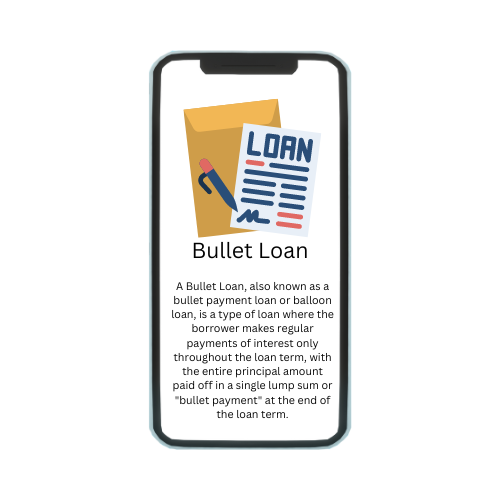What Is A Bullet Loan?
A Bullet Loan, also known as a bullet payment loan or balloon loan, is a type of loan where the borrower makes regular payments of interest only throughout the loan term, with the entire principal amount paid off in a single lump sum or “bullet payment” at the end of the loan term.
Characteristics of a Bullet Loan:
- Payment Structure:
- Interest Payments: Borrowers typically make periodic payments of interest only during the loan term. These payments can be monthly, quarterly, or semi-annually, depending on the terms agreed upon.
- Principal Payment: Unlike traditional loans where the principal is repaid gradually over time, the entire principal amount is due as a single payment at the end of the loan term. This payment is often referred to as the “bullet payment.”
- Loan Term: Bullet loans are often short to medium-term loans, typically ranging from a few months to several years. The exact term is agreed upon between the borrower and the lender at the time of loan origination.
- Purpose: Bullet loans are commonly used in situations where the borrower anticipates having sufficient funds to repay the principal amount in full by the end of the loan term. This can include scenarios such as:
- Financing for real estate developments where the property will be sold or refinanced to generate the necessary funds for the bullet payment.
- Business investments or projects where future cash flows or proceeds from asset sales are expected to cover the repayment.
- Risk and Considerations:
- Refinancing Risk: There is a risk that the borrower may not be able to refinance or secure funds to make the bullet payment at the end of the loan term. This risk can be mitigated by ensuring there are sufficient alternative sources of repayment.
- Interest Rate Risk: If interest rates increase during the loan term, the cost of refinancing the bullet payment could rise, potentially impacting the borrower’s ability to repay.
- Cash Flow Management: Borrowers must carefully manage their cash flow to ensure they can make the interest payments on schedule and prepare for the bullet payment at the loan’s maturity.
Types Of Bullet Loans
In the context of loans in India, the term “bullet loan” isn’t commonly used with the same specific meaning as in international finance. However, there are types of loans in India that share similarities with aspects of bullet loans in terms of repayment structures or purposes. Here are some types of loans in India that can be loosely associated with bullet loan characteristics:
- Short-Term Loans:
- Purpose: Short-term loans in India are typically used for financing immediate business needs or projects where the borrower expects to generate sufficient funds to repay the loan quickly.
- Repayment: These loans often have a short repayment period, and the borrower may plan to repay the principal in full at the end of the term, similar to a bullet payment concept.
- Bridge Loans:
- Purpose: Bridge loans in India are used to bridge the gap between immediate cash needs and a longer-term financing arrangement or an anticipated source of funds.
- Repayment: They often involve interest-only payments during the term, with the principal repayment due in full at the end of the loan term, resembling the bullet payment structure.
- Real Estate Financing:
- Purpose: Loans for real estate development or construction projects in India may have structures where interest payments are made periodically, with the principal repayment expected from project completion proceeds or refinancing.
- Repayment: Developers may use the proceeds from property sales or project completion to make a lump-sum repayment, akin to a bullet payment, at the loan’s maturity.
- Balloon Payment Loans:
- Purpose: Certain types of loans in India, especially in the context of vehicle financing or personal loans, may involve balloon payments where the borrower makes smaller periodic payments over the loan term and a large final payment to cover the remaining principal at the end.
- Repayment: This structure resembles the bullet payment concept, where the significant portion of the principal is due as a lump sum at the end of the loan term.
Important Considerations:
- Risk Management: Borrowers must carefully manage their repayment strategy to ensure they have adequate funds or alternative sources to make the lump-sum payment at the end of the loan term.
- Interest Rates: Fluctuations in interest rates can affect the cost of refinancing or securing funds for the bullet payment, necessitating proactive financial planning.
- Regulatory Framework: Loan structures in India are governed by regulatory guidelines from the Reserve Bank of India (RBI) and other authorities, influencing terms, conditions, and permissible structures.
Advantages Of Bullet Loans
Bullet loans, or loans with characteristics similar to bullet payments, offer several advantages for borrowers in certain financial situations. Here are some key advantages of bullet loans:
- Lower Initial Payments: Bullet loans often involve interest-only payments during the loan term. This means that borrowers have lower monthly payment obligations compared to traditional loans where principal repayments are also required. This can improve cash flow management, especially for businesses or individuals with irregular income streams or specific financing needs.
- Flexibility in Repayment: Borrowers benefit from flexibility in structuring the repayment of the principal amount. By deferring the repayment of the principal until the end of the loan term, borrowers can align the payment with anticipated future cash inflows, such as proceeds from the sale of an asset, project completion, or refinancing.
- Interest Cost Management: Interest-only payments on bullet loans allow borrowers to manage their interest costs more effectively. This can be advantageous in scenarios where the borrower expects to earn a return on invested capital that exceeds the cost of borrowing, thereby potentially increasing overall profitability.
- Strategic Use of Funds: Bullet loans are often used strategically for financing projects or investments where immediate capital is needed, but repayment of the principal can be deferred until specific future events or milestones are achieved. This allows borrowers to deploy capital efficiently without immediate financial strain.
- Short-Term Financing Needs: Bullet loans are suitable for short-term financing needs, such as interim financing for real estate development, bridging funding gaps in business operations, or financing specific projects where the timing of cash flows is predictable.
- Simplicity in Structure: The structure of bullet loans is often straightforward, focusing on interest payments during the term and a single lump-sum payment of principal at maturity. This simplicity can streamline loan management and administration for borrowers and lenders alike.
- Potential Tax Benefits: Depending on the jurisdiction and specific circumstances, interest payments on loans may be tax-deductible. By focusing on interest payments during the loan term, borrowers may capitalize on potential tax benefits associated with interest expense deductions.
- Enhanced Cash Flow Predictability: For borrowers with predictable future cash flows or liquidity events, such as seasonal businesses or project-based revenues, bullet loans provide predictability in managing financial obligations and planning for the lump-sum repayment.
Risks Associated With Bullet Loan
Bullet loans, despite their advantages, also pose several risks that borrowers need to consider carefully before opting for this type of financing. Here are some key risks associated with bullet loans:
- Refinancing Risk: One of the primary risks of bullet loans is the need to refinance or repay the entire principal amount in a lump sum at the end of the loan term. If borrowers are unable to secure financing or sufficient funds to make the bullet payment, they may face financial strain or default on the loan.
- Interest Rate Risk: Bullet loans expose borrowers to interest rate risk, especially if interest rates rise significantly during the loan term. Higher interest rates can increase the cost of refinancing the bullet payment or lead to higher future interest expenses if the loan is rolled over into a new term.
- Cash Flow Management: Since bullet loans typically require interest-only payments during the loan term, borrowers must ensure they have adequate cash flow to meet these obligations. Inadequate cash flow management can lead to liquidity challenges or difficulty in making timely interest payments.
- Market and Economic Conditions: Economic downturns or unfavorable market conditions can impact the borrower’s ability to generate sufficient funds for the bullet payment. Changes in business conditions, property values (in case of real estate projects), or asset sale prices can affect the feasibility of repayment.
- Dependency on Future Events: Bullet loans often depend on anticipated future events or cash inflows, such as proceeds from asset sales, project completion, or refinancing. If these events do not materialize as expected, borrowers may struggle to repay the loan on schedule.
- Risk of Non-Repayment: If borrowers fail to repay the bullet payment at the end of the loan term, lenders may impose penalties, fees, or initiate legal actions to recover the outstanding amount. This can damage the borrower’s creditworthiness and financial standing.
- Regulatory and Compliance Risks: Depending on the jurisdiction and type of loan, bullet loans may be subject to regulatory requirements or restrictions. Non-compliance with regulatory guidelines can lead to legal consequences or additional costs for borrowers.
- Limited Flexibility: Bullet loans offer less flexibility compared to traditional loans with gradual principal repayment. Borrowers must carefully plan and forecast their financial obligations to ensure they can meet the bullet payment obligation at maturity.
Mitigating Risks:
- Financial Planning: Conduct thorough financial analysis and planning to assess the feasibility of making the bullet payment at the end of the loan term.
- Risk Management Strategies: Implement risk management strategies, such as hedging against interest rate fluctuations or diversifying funding sources, to mitigate financial risks associated with bullet loans.
- Negotiate Terms: Negotiate favourable terms with lenders, including flexibility in repayment options or conditions based on anticipated cash flows or financial events.
- Monitor Market Conditions: Stay informed about economic and market conditions that could impact the borrower’s ability to repay the loan and adjust financial strategies accordingly.
Bullet Loan Vs Amortization Loan
The comparison between a Bullet Loan and an Amortization Loan primarily revolves around their repayment structures and how they handle principal payments over the loan term:
Bullet Loan:
- Repayment Structure:
- Interest Payments: Borrowers typically make regular interest payments during the loan term. These payments cover the cost of borrowing but do not reduce the principal amount.
- Principal Payment: The entire principal amount is due as a single lump sum or “bullet payment” at the end of the loan term. This means that throughout the loan term, the borrower focuses on servicing interest obligations and plans to repay the principal in full at maturity.
- Cash Flow Management:
- Bullet loans provide lower initial payments (interest-only payments), which can improve cash flow management in the short term. However, they require careful financial planning to ensure funds are available for the bullet payment at the end of the loan term.
- Usage:
- Bullet loans are often used for short-term financing needs or specific projects where borrowers expect future cash inflows (e.g., from asset sales or project completion) to cover the lump-sum repayment.
Amortization Loan:
- Repayment Structure:
- Principal and Interest Payments: Amortization loans involve regular payments that cover both principal and interest. Each payment reduces the outstanding balance (principal) over time.
- Gradual Reduction: With each payment, the borrower’s debt decreases until the entire loan is fully repaid by the end of the loan term. This gradual reduction in principal balances the loan over time.
- Cash Flow Management:
- Amortization loans require higher periodic payments compared to bullet loans because each payment includes both interest and a portion of the principal. This can affect short-term cash flow but reduces the risk of a large lump-sum payment at maturity.
- Usage:
- Amortization loans are common for long-term financing needs, such as mortgages, where borrowers prefer a structured repayment plan that steadily reduces debt over time and spreads out repayment obligations.
Comparison:
- Payment Structure: Bullet loans focus on interest-only payments with a single large principal payment due at maturity, while amortization loans involve regular payments that gradually reduce both principal and interest over the loan term.
- Risk and Management: Bullet loans carry refinancing risk at maturity, as borrowers must secure funds or refinance the lump-sum principal payment. Amortization loans spread repayment obligations evenly over time, reducing the risk of a sudden large payment but requiring higher ongoing payments.
- Flexibility vs. Stability: Bullet loans offer flexibility in cash flow management initially but require careful planning for the bullet payment. Amortization loans provide stability with predictable payments but may limit short-term cash flow flexibility due to higher regular payments
Conclusion
Bullet loans offer flexibility and strategic advantages for borrowers seeking to manage cash flow, align repayment with future financial events, and optimize the use of borrowed capital for short-term financing needs. However, careful assessment of repayment capabilities and financial risks is essential to maximize the benefits of this loan structure.






